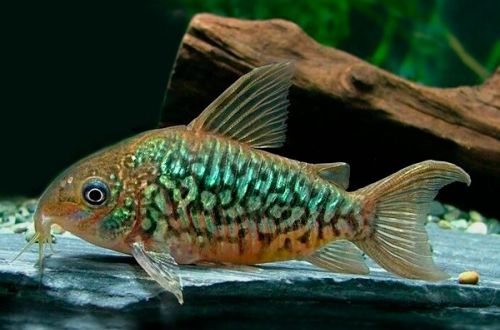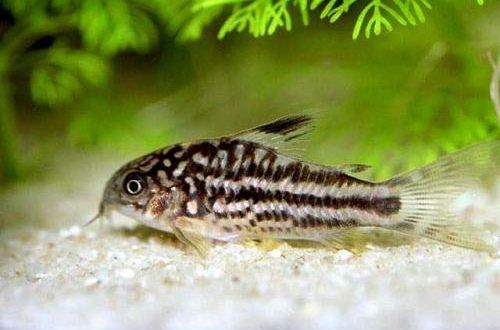
Corridoras pantanalensis
Corydoras pantanalensis, scientific name Corydoras pantanalensis, belongs to the family Callichthyidae (Shell catfish). The catfish is native to South America. It is found in the region known as the Pantanal, a vast wetland located on the border of Brazil, Bolivia and Paraguay. A typical biotope is a stagnant body of water with clear water and dense vegetation.

Contents
Description
Adult individuals reach a length of about 8 cm. The catfish has a shape and body structure characteristic of the Corydoras, which is covered with rows of bone plates, and the pectoral fins are equipped with sharp spikes.
At a young age, males and females do not differ from each other. The color is gray-brown with a greenish sheen. As they grow older, the males show a reticulate pattern, and emerald green colors begin to predominate in the color. In females, the color does not change.
Behavior and Compatibility
Peaceful friendly fish. It gets along well with other popular aquarium species of comparable size and temperament. Prefers to live in packs. It is recommended to purchase in groups of 3-4 individuals.
Brief information:
- The volume of the aquarium – from 80 liters.
- Temperature – 22-26°C
- Value pH — 6.5–7.5
- Water hardness – soft (1-12 dGH)
- Substrate type – any soft
- Lighting – bright
- Brackish water – no
- Water movement – little or no
- The size of the fish is about 8 cm.
- Food – any sinking food
- Temperament – peaceful
- Keeping in a group of 3-4 fish
Maintenance and care, arrangement of the aquarium
The optimal size of the aquarium for a group of 3-4 fish starts from 80 liters. The design uses soft substrates and many aquatic plants. The lighting is bright.
A comfortable environment is considered to be warm, soft, slightly acidic water and the absence of an internal current. As a filtration system in small tanks, it is desirable to use simple airlift filters.
With long-term maintenance, the accumulation of organic waste should not be allowed. Dirty soil can cause disease and lead to infection of sensitive antennae in catfish.
It is necessary to observe the regular maintenance of the aquarium. At least once a week, clean the soil and replace part of the water with fresh water.
Food
They accept most foods in dry, frozen and fresh form. Sinking foods such as flakes and pellets are good choices, as are bloodworms, daphnia, brine shrimp, small gammarus, and other invertebrates.
Breeding / breeding
Probably, the breeding of Corydoras pantanalensis is similar to other representatives of the genus. The stimulus for spawning is a change in the external environment. In nature, this is the beginning of the rainy season. The aquarium produces a gradual decrease in temperature, increase the level of oxygen (additional aeration) and include food rich in protein, such as bloodworms. Catfish do not show parental care and are prone to predation in relation to their own offspring. When breeding, use a separate spawning aquarium.
More details about breeding Corydoras are described in a separate article.
Sources: fishbase.de, planetcatfish.com





